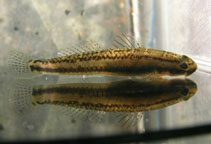| Family: |
Gobiidae (Gobies), subfamily: Sicydiinae |
| Max. size: |
8 cm SL (male/unsexed) |
| Environment: |
benthopelagic; freshwater; brackish; marine, amphidromous |
| Distribution: |
Asia: Hainan Island and the mainland of South China (probably endemic to China). Also from Japan (Ref. 93128). |
| Diagnosis: |
Dorsal spines (total): 7-7; Dorsal soft rays (total): 9-9; Anal spines: 1-1; Anal soft rays: 10-10. This species is a large-sized Stiphodon with the pectoral fin spotted and sexual dimorphism obvious. Mature male has the upper one-third of the body khaki and lower part silvery grey/ grayish brown (some individuals would be darker in colour) with 9-10 lateral bars, first dorsal fin elongated, triangular and sometimes filamentous, predorsal midline without scales or with very few scales (certain individuals would have some scales); while the female has creamy with two obvious transverse stripes on the body, sometimes with several dull lateral bars, dorsum with several gold bars, ventrum light blue. |
| Biology: |
Adults inhabit clear streams and mainly feed on epiphyte and biofilm on rocks in the wild. Due to its possible amphidromous nature, as known to occur with its congeners (adults live and breed in freshwater streams; larvae hatched drift downstream and develop in marine environments; juveniles return to freshwater streams), blockage of the migration pathway (e.g. construction of dam or culvert in streams) would cause a significant impact on this species. Ensuring no net loss of habitat, keeping the natural stream flow and maintaining the stream-ocean corridor are all essential for preserving this species (based on researches on its congeners; see Ref. 82683, 82684, 82685, 82689, 82690, 82692). Collection conducted by aquarium hobbyists (both private and commercial) also poses a serious threat to Stiphodon species in some regions (Ref. 82684) and this kind of activity should be strictly controlled (Ref. 82694). |
| IUCN Red List Status: |
Data deficient (DD); Date assessed: 20 January 2019 Ref. (130435)
|
| Threat to humans: |
harmless |
| Country info: |
|
Source and more info: www.fishbase.org. For personal, classroom, and other internal use only. Not for publication.

